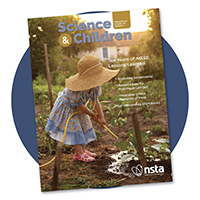Author Guidelines
Science & Children

Science & Children
Science and Children is an award-winning, peer-reviewed, practitioners’ journal. Subscribers are members of the National Science Teaching Association who select it as their preferred journal. We hope you will consider writing a manuscript for Science and Children to interest our readers and enhance preschool and elementary science teaching. NSTA offers no remuneration for published articles.
Questions?
Contact managing editor Valynda Mayes at vmayes@nsta.org.
Audience
-
PreK-5 teachers
-
University faculty
-
State and district supervisors and leaders
Schedule
Six times a year
Formats
Print and e-journal
Your Manuscript
See our detailed manuscript preparation guidelines.
Create
Create a Manuscript
We seek manuscripts that detail innovative, classroom-tested preschool and elementary school science activities and strategies that demonstrate current research regarding the teaching and learning of science as in the Framework for K–12 Science Education.
Need Some Help?
FREE Web Seminar Recording:
Write From the Start
We Publish...
Themes
Each issue of Science and Children is centered on a theme that focuses on practical, timely classroom ideas and strategies that appeal to a preschool and elementary-level audience.
Non-Theme
To provide our readers with a broad spectrum of ideas, we also regularly publish articles that are not theme-based. Science and Children also publishes several columns that focus on specific topics.
Feature Articles
Feature articles that describe classroom activities should demonstrate current research regarding the teaching and learning of science as exemplified in the Framework for K–12 Science Education. For example, are students explaining phenomena or designing solutions? Are the three dimensions integrated for both instruction and assessment? Are there opportunities for students to express and clarify their ideas? Is the context relevant and authentic to students?
Manuscripts that describe a classroom activity should also provide the following:
-
content area, grade level, big idea/unit, essential pre-existing knowledge, time required, cost;
-
a description of the phenomena being explored and the sensemaking tasks that students are engaged in as they figure out science and/or design solutions
-
descriptions of how students are doing science and/or engineering through the science and engineering practices (Framework for K–12 Science Education)
-
examples of teacher and student interactions;
-
suggestions for managing the activity, such as monitoring student engagement; and distributing, storing, and disposing of materials and equipment;
-
all aspects of the learning experience from pre-assessment through summative assessment;
-
Word documents of supplemental materials such as worksheets, checklists, assessments, and rubrics that enable the reader to quickly integrate your described activity into their classroom;
-
safety precautions. See NSTA Safety in the Science Classroom, Laboratory, or Field Studies to assist you. Learn More
-
support for claims made in the manuscript, including research citations and personal anecdotal evidence.
We Do Not Publish...
-
Manuscripts that do not reflect current research regarding the teaching and learning of science as exemplified in A Framework for K–12 Science Education
-
have been previously published in either print or digital format (websites, blogs, e-books, etc.);
-
focus on research without providing ample practical details for the classroom application of the research results or ideas;
-
contain material that is not original, or does not provide a unique approach to a classic activity;
-
are strictly opinions, personal reflections, travelogues, or diary-type submissions;
-
are term papers, dissertations, university writing assignments, outlines of lesson or unit plans, lists of ideas, or reviews of literature;
-
promote a commercial product such as materials, books, software, or professional services;
Questions?
If you have any questions about the submission process, please contact the Science and Children editor by email.
Valynda Mayes, Managing Editor


